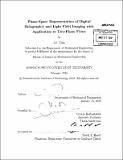Phase-space representation of digital holographic and light field imaging with application to two-phase flows
Author(s)
Tian, Lei, Ph. D. Massachusetts Institute of Technology
DownloadFull printable version (15.78Mb)
Other Contributors
Massachusetts Institute of Technology. Dept. of Mechanical Engineering.
Advisor
George Barbastathis.
Terms of use
Metadata
Show full item recordAbstract
In this thesis, two computational imaging techniques used for underwater research, in particular, two-phase flows measurements, are presented. The techniques under study, digital holographic imaging and light field imaging, are targeted at different flow conditions. In low-density flows, particles and air bubbles in water can be imaged by a digital holographic imaging system to provide 3D flow information. In the high density case, both occlusions and scattering become significant, imaging through these partial occlusions to achieve object detection is possible by integrating views from multiple perspectives, which is the principle of light field imaging. The analyses on the digital holographic and light field imaging systems are carried out under the framework of phase-space optics. In the holographic imaging system, it is seen that, by tracking the Space bandwidth transfer, the information transformation through a digital holographic imaging system can be traced. The inverse source problem of holography can be solved in certain cases by posing proper priori constraints. As is in the application to two-phase flows, 3D positions of bubbles can be computed by well tuned focus metrics. Size statistical distribution of the bubbles can also be obtained from the reconstructed images. (cont.) Light field is related to the Wigner distribution through the generalized radiance function. One practical way to sample the Wigner distribution is to take intensity measurements behind an aperture which is moving laterally in the field. Two types of imaging systems, the light field imaging and the integral imaging, realize this Wigner sampling scheme. In the light field imaging, the aperture function is a rect function; while a sinc aperture function in the integral imaging. Axial ranging through the object space can be realized by digital refocusing. In addition, imaging through partial occlusion is possible by integrating properly selected Wigner samples.
Description
Thesis (S.M.)--Massachusetts Institute of Technology, Dept. of Mechanical Engineering, 2010. Cataloged from PDF version of thesis. Includes bibliographical references (p. 125-133).
Date issued
2010Department
Massachusetts Institute of Technology. Department of Mechanical EngineeringPublisher
Massachusetts Institute of Technology
Keywords
Mechanical Engineering.